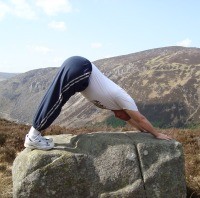We don’t really give a lot of importance to noses.
Good for olfactory stuff like smelling and remembering things by their smell. Terrible irritation if you’ve a cold and up and till the point I started practising yoga, my nose was just partner to my ears in the chore of keeping my spectacles in check.
Our nostrils are important, though: they’re designed as a filter, keeping out atmospheric detritus like dust and pollen and, more importantly, they warm and moisten the air before it gets inside the body. We don’t as a rule, pay too much attention to our breathing, our bodies just kinda get on with it while we can pay more attention to the latest episode of “Game of Thrones”.
And this is where we make the mistake. Because sometimes we forget and we breathe through our mouths and this can cause some serious health problems. Chest infections, bronchitis, stress, anxiety, heart disease (yes heart disease), irritable bowel syndrome and asthma, are just some of the problems caused or made worse by breathing through the mouth. The mouth wasn’t designed for breathing. Kissing, eating, drinking and talking and singing (on an outbreath) maybe, but not for breathing.
As a child I had problems with ADD and couldn’t concentrate in school. The teacher noticed I wasn’t breathing through my nose and made the connection. After operations to remove my severely swollen tonsils and adenoids, I started breathing through my nose and could concentrate. And, all through my childhood and into my adulthood I struggled with a stutter which I am now completely cured of because of the breathing techniques I practised doing yoga.
We have two nostrils for a reason. We don’t continually breath through both at the same time, the nostrils take turns of around ninety minutes each with about 10 minutes in between where both nostrils take in air. In yoga it’s believed that there are channels running through the body called Nadi. There are 72,000nadis in the body (lymph system), but the three main nadis are; Sushumna, which runs from the base of the spine to the juncture of the lamboid and sagittal suture of the cranium, Pingala which runs to the right of the body (from the left testicle), relates to the sun, warmth and positive polarity and ends in the right nostril. It also has control over the left hemisphere of the brain.It is extrovert, male and controls all the vital processes of the body and relates to the sympathetic nervous system. Ida is the female, lunar energy. It is cool, introverted, is negative in polarity and controls the right hemisphere of the brain and mental processes of the body. It runs from the right testicle to the left nostril and relates to the parasympathetic nervous system.
The male energy of pingala in the right nostril works with the left hemisphere of the brain which is our analytical side. We use this side for decision making, mathematics etc. The female energy of Ida in the left nostril, works with the right hemisphere of the brain which we use for feeling, intuition, music and art etc. When going to bed at night, it is better to lay on the right side of the body to open the left nostril so that the mind is calm and sleep comes easily. Lying on the left side will cause the right nostril to be open and will cause the mind to analyse all the days events and sleep will not come easily… This, funnily enough relates to the old term “getting out of bed on the wrong side”!
The practice of yoga starts with postures and exercise to get the body ready for Pranayama which is the breath exercises. Pranayama helps the Ida and Pingala Nadis to become balanced, which is then favourable for the practice of Meditation. But Because Pranayama helps to open up Ida and pingala (left and right nostrils) it exercises our mental abilities like memory, intuition, decision making as well as physical abilities like the digestion, circulatory, endocrine as well as obviously the respiratory system. In Pranayama the breath is restrained slighty and controlled so that we get more oxygen out of the air we breathe and can be useful in raising or lowering blood pressure. It can also bring heat to the body if we are cold, or can cool the body if we are too warm.
In the book “Light on Pranayama” by B.K.S. Iyengar (available from crossroad publishing) it is written;
Pranayama is not just automatic habitual breathing to keep body and soul together. Through the abundant intake of oxygen by its disciplined techniques, subtle chemical changes take place in the sadhaka’s (student’s) body. The practice of asanas removes the obstructions which impede the flow of prana and the practice of Pranayama regulates that flow of Prana throughout the body. It also regulates the Sadhaka’s thoughts, desires and actions, gives poise and the tremendous will power needed to become a master of oneself.
~
Via Yogitobye.com





Read 8 comments and reply